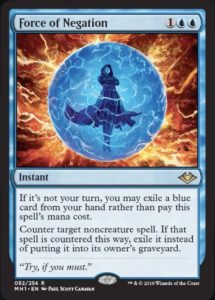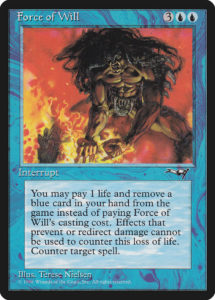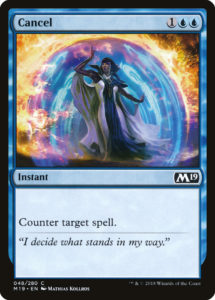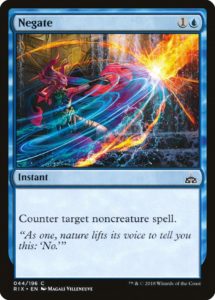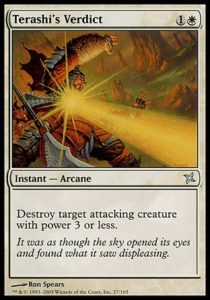Modern Horizons spoiler season has begun! Cards are being added directly to Modern without going through Standard for the first time ever. We’re getting hundreds of brand new cards! In other words, we’re living in exciting times (especially exciting times, considering War of the Spark came out this month).
Since we’re getting loads of new cards, I expect most of the commons and uncommons to be more focused on Commander, Cube, and Modern Horizons Limited than Modern. After all, it’s hard to introduce hundreds of new, relevant, and pushed cards without completly breaking a format. That said there is one new card that is clearly designed with Modern in mind:
Clear Utility, Unclear Consequences
There’s a lot to unpack with Force of Negation, but let’s start with its apparent ancestor: Force of Will. Force is one of the key components that keep Legacy’s high-speed combo decks (like Goblin Charbelcher) in check. It’s one of the core enablers of “fair” decks. Absent such a card, it’s difficult to disrupt fast combo and turn one combo decks run the risk of being unbeatable (although they tend to have high fail rates). Such a failsafe seems important in an increasingly fast Modern—once upon a time, decks were banned for breaking the “turn three rule” and winning before turn four (locking up the game) too consistently. Nowadays, decks are routinely locking up the game on turn three and some, such as Neoform combo, threaten to win on the very first turn.
Modern has never had such a “fair” card as Force of Negation. The closest analogue, Pact of Negation, is far more potent at defending Ad Nauseam, Neoform, and Amulet of Vigor combo decks than it is at disrupting them. Force of Negation is clearly intended to turn the tables. That said, it’s unclear just how powerful Force of Negation will be. It’s similar to Force of Will, but there are three significant differences that each need to be examined: the alternate cost, the actual mana cost, and the effect.
We’ll start with the most dramatic part: it’s “free.”
Manaless Cost
There’s something exciting about getting something for nothing. Few things are more integral to Magic than its mana system and few things are more powerful than those that circumvent it. Both Force of Will and Force of Negation can do those thanks to their alternate costs. Of course, there are two key differences between their alternate costs.
The similarities are stark—both cards involve card disadvantage (by requiring you to pitch a card), both cards contort your deckbuilding incentives (by making you play a large quantity of blue cards), and both cards can be cast for zero mana (which is a huge deal). Their first difference is slight—Force of Will requires a life payment (a small price to pay, but not an irrelevant one in a format full of aggro-combo decks and Burn), so the point goes to Force of Negation. Of course, there’s the major difference:
…if it’s not your turn…
This is a significant downside. Force of Negation cannot be used to protect your combo (okay, most of the time—it still works for Ad Nauseam). It cannot be used to force through your Jace or Teferi through a counter war. Force of Negation is designed to disrupt some crazy thing your opponent is doing or hamper their ability to respond to your threats at sorcery speed, not to disrupt their ability to interact with you on your turn.
The best Force of Negation decks should be those that don’t mind this downside. These are likely control decks and tempo-aggro decks. Decks like Azorius-based Control need early disruption, aren’t trying to protect any combo or core component of their own, and have Planeswalkers to recoup their lost card advantage later on. They can use Force of Negation to stay alive to resolve a Planeswalker and then protect it after tapping out to play it. We might also see a resurgent of actual Delver of Secrets decks that want to stymie combo decks while also playing Arclight Phoenixes of their own.
The Full Price
Looking at Force of Will and Force of Negation‘s mana costs, there’s a clear winner. Force of Negation is cheap enough to actually cast. Sure, three mana is a hefty price in Modern, but five mana is usually only available after the winner is mostly determined (or Tron has come online). This means that Force of Negation remains viable postboard in some fair matches (where in Legacy, Force of Will often comes out) and that you aren’t priced in to always pitching a card to Force something.
It’s easy to miss this detail when comparing their alternate costs and actual effects, but on actual mana cost, Force of Negation is way more efficient than Force of Will. Force of Will costs two or three mana more than a hard Counterspell does (an increase in cost of 100-150%), whereas Force of Negation only costs one more than Negate (a 50% increase in cost). This reduces the deckbuilding cost to a reasonable extent, something which should not be understated.
The Effect
Force of Will is an incredibly powerful and often frustrating spell. It provides blue mages the simple power to simply say no to anything. (Well, basically anything. Stuff like Abrupt Decay and Aether Vial exist.) Force of Negation does not have that power. It can stop a Faithless Looting (and even exile it!), Cranial Plating, Karn Liberated, or Life from the Loam (it exiles this, too!), but it can’t stop a Thing in the Ice, Arcbound Ravager, Wurmcoil Engine, or Stitcher’s Supplier.
Force of Negation isn’t a jack-of-all trades, but a flexible silver bullet that can shut down key cards in most Modern decks. Most decks will have excellent targets for it, but some (like Humans) have few. This is a major drop in power relative to Force of Will. The big question is whether this loss in power is compensated by the lower power level of Modern relative to Legacy, and how necessary a free Negate is. If the format is defined by creature decks like Humans, Burn, Spirits, and even Affinity, Force of Negation might not be effective (but WU Control would be pretty good). However, if we continue to see Dredge, Arclight Phoenix, and Tron, then Force should be a strong addition to the field.
So, How is it?!
The short answer is that time will tell. There’s certainly hope for Force of Negation, given that Negate has already seen some maindeck play. The advent of Neoform combo and the possibility of the London Mulligan’s return likely increases the demand for cards which can fight high speed, fragile combo. Force of Negation‘s mere existence might reduce the amount of fragile combo decks, since there’s less incentive to mulligan to go off on turn one when your opponent might have the answer for it on turn zero. I for one am excited to sleeve up some Modern again and protect my Teferis for free while having better disruption against Dredge and Tron. Or maybe I’ll shave on Planeswalkers and just cast Fact or Fiction. But that said, we’ve got some time before we get to playtest with Force of Negation, and we’ve still got an entire spoiler season to see what else changes up Modern! So that’s where we’ll leave off for today.
And, as always, thanks for reading.
—Zachary Barash is a New York City-based game designer and the commissioner of Team Draft League. He designs for Kingdom Death: Monster, has a Game Design MFA from the NYU Game Center, and does freelance game design. When the stars align, he streams Magic.
His favorite card of the month is Deadly Recluse. In some formats, it’s a Doom Blade. In others, it’s a weak-hitting two drop. It’s a super context-sensitive card that punishes aggression and is punished by both control decks. It does a whole lot for a Squire with two keywords.

